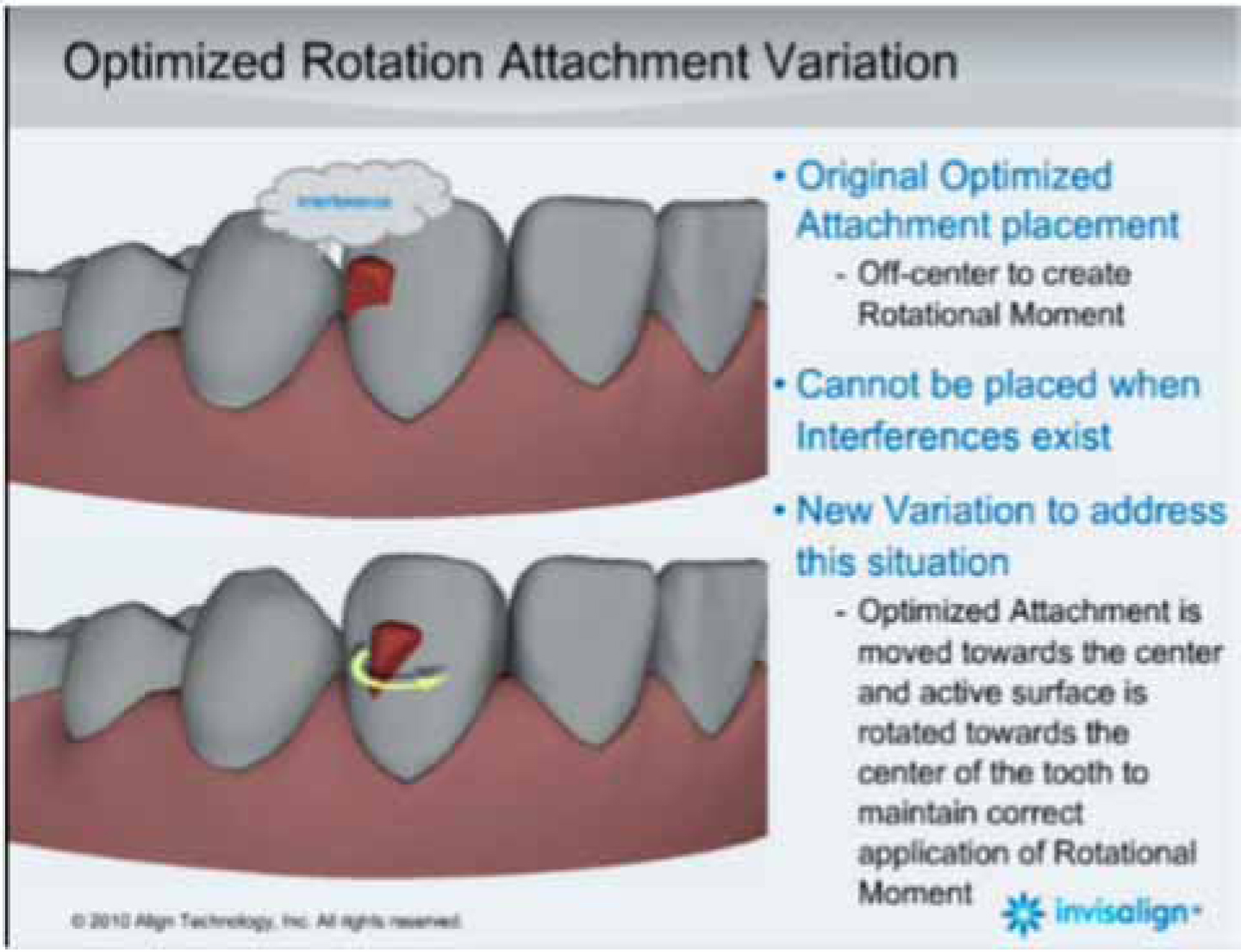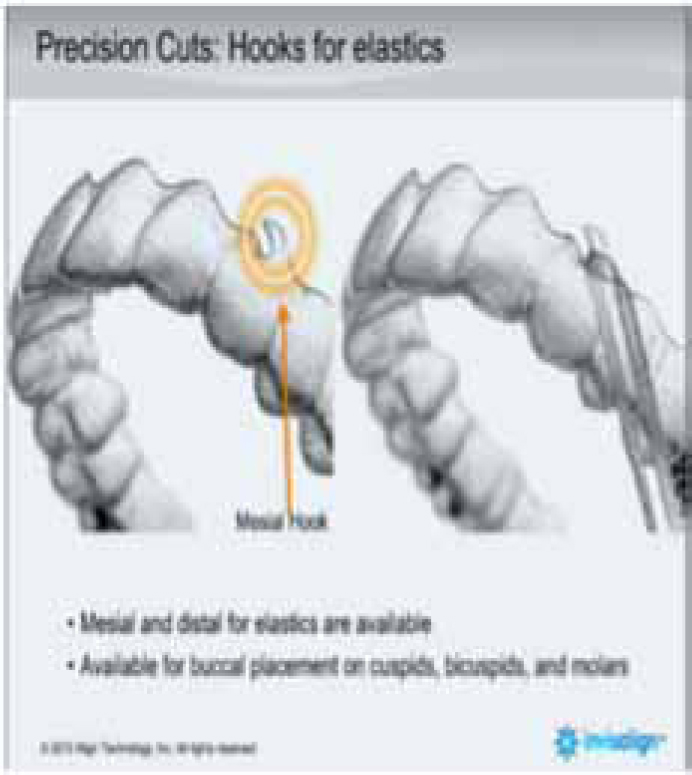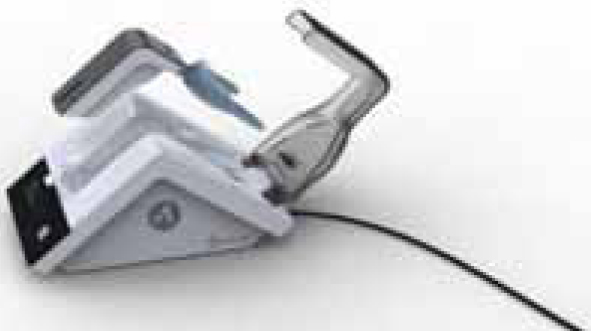References
How to incorporate recent improvements in invisalign into clinical practice
From Volume 4, Issue 3, July 2011 | Pages 78-80
Article

The author has been using Invisalign since 2002 and, over the last eight years, has treated in excess of 300 patients using this technique. Over the years there have been many improvements and modifications, referred to in previous articles,1,2 to overcome some of the limitations of using the appliance and these will be discussed in this article. All of the modifications are now available in the UK since the launch of Invisalign G3 in May 2011.3
Power ridges
Power ridges (Figure 1) are built into the aligner in both the upper and lower incisor region, where torque of the incisors is required. Initially, these were only being placed on the labial surface of these teeth, but a weakness of this was that, when retraction and torquing of the upper incisors were required at the same time, this did not, in fact, happen and only tipping occurred. In order to overcome this, palatal/lingual power ridges (Figure 2) have also been placed to affect the moment of force.


Attachments
Attachments have now been modified and a new protocol developed for both canine and premolar rotations (Figure 3). These attachments do not have to be asked for specifically, but will automatically be placed on these teeth as a standard protocol in the upper premolar region.

The degree of rotation that can be satisfactorily achieved with aligners has increased from a maximum of 30° to 45°. The maximum rotational velocity remains at 2° per stage.
Extrusion of teeth is known to be very difficult, especially with aligners, but, here again, after a considerable level of clinical and scientific research, the extrusion attachments have been modified to help in overcoming the limitation of the aligners in producing extrusion. However, this remains a difficult movement to achieve with aligners alone.
When placing attachments in the past, the author would use an orthodontic composite, because of ease of removal. However, the weakness of this was that the composite would wear too quickly, compromising the working of the aligners. The author now uses a restorative composite with a high level of filler (Figure 4).

Interproximal Reduction (IPR)
The author often found, when checking a patient's clincheck, that the technicians would request IPR before the contact points were accessible and, if this was not picked up when checking clincheck, then it could be very awkward, if not impossible, to get good access, with the result that the IPR would be poorly carried out. Now the software has become much more intuitive and clincheck will only ask you to do IPR when the contact areas are accessible. This results in a slight amount of round tripping but is a much more satisfactory approach.
Research at the University of Florida by Wheeler has shown that, with increasing age, tooth movement slows down.4 This has changed the author's protocol for patients over the age of 35 to slowing down the movements that are shown on the clincheck. So, for instance, if the clincheck shows 20 aligners to produce a certain number of movements, the author would modify this and slow it down to perhaps 30 aligners, to achieve the same movements.
Over the years, the author has become more ambitious in the types of malocclusions he treats with Invisalign.
More cases are treated that require distal movement in conjunction with Class II elastics to reinforce anchorage. The Class II elastics would be fitted by either making a slit in the aligners to hook on the elastics or by placing a button on the upper canines and lower molars. The elastics used are ¼'' 3½ or 4½ ounces. If distalization is more than 3 mm, the author might start with a Carriere appliance (Figure 5), used with Class II elastics to distalize the molars before starting the Invisalign. Once a Class I molar relationship has been achieved, a vacuum-formed retainer would be made to take impressions of the Invisalign to be made. This technique has been described by Schupp et al.5

In October 2010, in the US, Align Technology released Invisalign G3. This is now available in the UK. One of the modifications that can be expected are being able to have preformed hooks built into the aligners (Figure 6) for Class II or Class III traction, negating the necessity of having to place slits by hand into each aligner, a tedious and time consuming exercise.

Another alternative modification that will be available preformed is the ability to have the aligners manufactured with the material removed (Figure 7), where one might like to place buttons on the teeth for Class II or Class III traction.

Passive aligners
Also available will be passive aligners. In the past, in a case where there may be 20 upper aligners but 16 lower aligners were needed, then the patient would continue wearing the last lower aligner until the 20 upper aligners had been used. With this new system, one would be able to order four passive aligners in the lower arch to be changed in sequence with the last four upper aligners.
AcceleDent
For the last year or so the author has been using a microvibrating device called AcceleDent (Figures 8 and 9) which, by means of microvibrations, increases osteoblastic, osteoclastic and osteocytic activity with the aim of decreasing treatment time with whatever orthodontic appliance is used. The author's protocol for changing aligners with Invisalign is to do this every two weeks, which is the recommended protocol. In the cases that have been treated with AcceleDent, the aligners have been changed every 10 days, which obviously speeds up mouth treatment and so far has shown no detrimental effects to the patients.


The science behind AcceleDent is robust. Initially, this technology had been used on long bones and Prof Jeremy Mao adapted the technique to work in the mouth.6 The force produced by AcceleDent is 25 g and the frequency is 30 Hz. The patient closes his/her mouth on the mouthpiece once a day for 20 min with the aligners in place and so far the feedback from them has been very positive.
Conclusion
Over the last few years, there have been many improvements in the design of the aligners and also various techniques that the author has found made results better and more predictable. Some of the techniques and tips outlined may prove useful in clinical practice.
